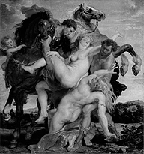| back to: Chapter 4 | Art, Issues, and Innovations in the Baroque Era |
|
The Last Judgement of Christ The Madonna of the Long Neck | REFORMATION
1517- Martin Luther posts his "95 Theses" on the door of the Wittenberg Cathedral Cathedral -Luther advocated hymns as a better way to communicate hard-to-understand mysteries of the Church and made music an integral part of Protestant Church services. COUNTER REFORMATION 1541- Michelangelo's Last Judgement of Christ is unveiled in the Sistine Chapel. Christ is shown as a young man and the scene is dominated by nude figures. Many criticize the work as an example of the licentiousness that has pervade the church. MANNERISM
-was a style that followed the Italian Renaissance which put emphasis on the individual style of the artist.
Parmagianino, Madonna of the Long Neck, 1534
Michelangelo, 1475-1564
|
The Ecstacy of St. Teresa David The Calling of St. Matthew |
BAROQUE IN ITALY Sculpture and Architecture Bernini -St. Peter's Colonnade, Rome, begun 1656 -Baldacchino, St. Peter's, Rome, 1624-33, gilded bronze, 95' high
-The Ecstacy of St. Teresa, 1645-52
-David, 1623, marble, lifesize
Painting
Annibale Carracci(1560-1609) ideal and Classical The Virgin Appearing to St. Luke and St. Catherine, 1592, Oil on canvas Carravaggio (1571-1610) naturalistic and "real"
The Calling of Saint Matthew, 1599-1600, Oil on canvas Judith Beheading Holofernes, c. 1598, Oil on canvas The Conversion of Saint Paul,1600-1601, Oil on canvas Artemisia Gentileschi (1593-1653)
Judith Beheading Holofernes, 1620, Oil on canvas |
 Rape of the Daughters of Leucippus Woman Holding a Water Pitcher The Little Children Being Brought to Jesus (100 Guilder Print) The Company of Frans Banning Cocq (Nightwatch) Rape of the Sabine Women Las Meninas |
BAROQUE IN EUROPE Flanders Peter Paul Rubens (1577-1640)
The Garden of Love, c. 1630-32, Oil on canvas
Rape of the Daughters 0f Leucippus- c.1635, oil on canvas, 6.5'x 8'
The Netherlands Rembrandt van Rijn (1606-69)
Self Portraits- conveyed these ideas of character in light and shadow
-Rembrandt was an excellent printmaker. He used a process called etching. This is a process that involves scratching into a metal plate, which has been covered with an acid-resistant coating, then dipping the plate in acid until it mars the surface of the plate. The plate is then washed, ink is pushed into the grooves left by the acid, and finally it is printed on paper. The Little Children Being Brought to Jesus ("The 100 Guilder Print"), Completed 1647-49, Etching and drypoint, 1st state The company of Frans Banning Cock preparing to march out, known as the Nightwatch, 1642, Oil on canvas Abraham and Isaac, 1634, Oil on canvas Jan Vermeer (1632-75)
View of Delft, c. 1660-1661, Oil on canvas The Art of Painting, c. 1666-1673, Oil on canvas Woman Holding a Water Pitcher- c.1664-5, oil on canvas, 16"x 15"
France Nicholas Poussin
-Most painters of the 17th and 18th Centuries allied themselves with either the Rubenists (bright vibrant color, painterliness, and exuberant brushwork) or the Poussinists (classical, idealist, and used a limited palette). The Rape of the Sabine Women, 1636-37, Oil on canvas Landscape with the Funeral of Phocion, 1648, Oil on canvas Phocion was a Greek who was executed because he would not conceal the truth. It is a comment on the Stoic nature of Phocion and reflects this in its sharp detail and calm. Spain
Las Meninas, 1656, Oil on canvas "Maids of Honor" (English translation) is a view into the artist's studio and the Royal family's lives. Innocent X, c. 1650 |
| Next study guide: Chapter 6 |

Custom Search
|